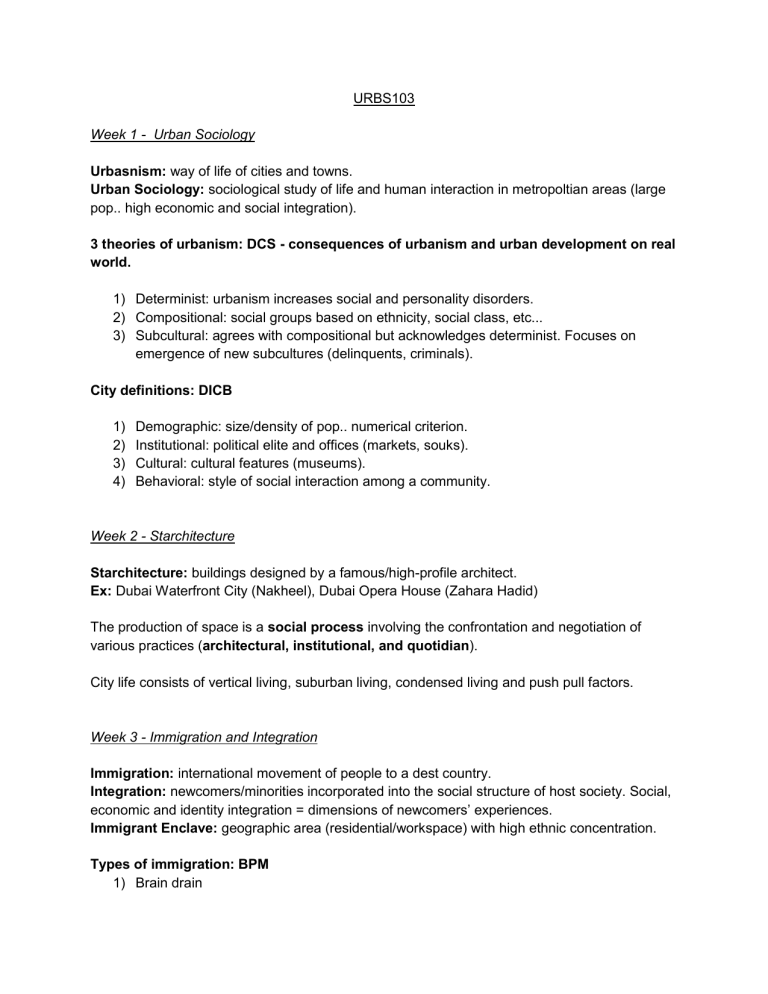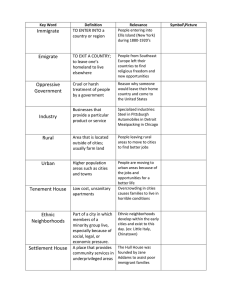
URBS103 Week 1 - Urban Sociology Urbasnism: way of life of cities and towns. Urban Sociology: sociological study of life and human interaction in metropoltian areas (large pop.. high economic and social integration). 3 theories of urbanism: DCS - consequences of urbanism and urban development on real world. 1) Determinist: urbanism increases social and personality disorders. 2) Compositional: social groups based on ethnicity, social class, etc... 3) Subcultural: agrees with compositional but acknowledges determinist. Focuses on emergence of new subcultures (delinquents, criminals). City definitions: DICB 1) 2) 3) 4) Demographic: size/density of pop.. numerical criterion. Institutional: political elite and offices (markets, souks). Cultural: cultural features (museums). Behavioral: style of social interaction among a community. Week 2 - Starchitecture Starchitecture: buildings designed by a famous/high-profile architect. Ex: Dubai Waterfront City (Nakheel), Dubai Opera House (Zahara Hadid) The production of space is a social process involving the confrontation and negotiation of various practices (architectural, institutional, and quotidian). City life consists of vertical living, suburban living, condensed living and push pull factors. Week 3 - Immigration and Integration Immigration: international movement of people to a dest country. Integration: newcomers/minorities incorporated into the social structure of host society. Social, economic and identity integration = dimensions of newcomers’ experiences. Immigrant Enclave: geographic area (residential/workspace) with high ethnic concentration. Types of immigration: BPM 1) Brain drain 2) Political refugees 3) Middleman minorities: used by dominant elites as a bufferto deflect mass frustration. Two theories: 1) Assimilation theory: socioeconomic mobility arises from increasing knowledge of the local culture and acceptance by the host society. 2) Culturalist theory: Immigrants and their descendants do not necessarily “melt” into the mainstream, preferring instead to preserve their distinct ethnic identities. Melting pot vs Salad bowl. - Migration would start with • Zero economic opportunity • Conflict or war • Persecution • Environmental disasters Week 4 - Apartheid stuff Types of segregation: LSGV 1) Legal 2) Social 3) Gated communities 4) Voluntary - Abandonment, crime, and social disorder, push poor black neighborhoods beyond the threshold of stability. Resegregation: As the percentage of blacks in a neighborhood rises, white demand for homes within it falls sharply while black demand rises. - Open housing act passed in the 1960s. - Only Puerto Ricans share blacks’ relative inability to assimilate spatially cause many of them are of African origin. Welfare dependency: Differences in class, gender, and neighborhood cumulate at each juncture of the welfare trajectory to produce much higher levels of welfare attachments among the ghetto population Week 5 - Capitalism Stratification: related to social structure and looks at the factors that determine a person’s position in society. Capitalism: an economic and political system in which a country's trade and industry are controlled by private owners for profit. Marxist Theory: is that profit arises out of the domination of labor by capital and that the capitalists as a class must expand the basis for profit. - The main problem with capitalism: a tendency to over-accumulation – too much capital is produced in relation to the opportunities to employ that capital. Primary circuit: investments in machinery and the production of manufactured goods. Secondary circuit: investments in infrastructure, the built-environment and services. Third circuit: investments in science and technology. - Author’s argument: The problem of over-accumulation stems from a process of overproduction in the primary circuit. One feasible solution to this problem would be to switch capital flows into the secondary circuit and third circuits. ^ investment in new machinery is easiest. Types of crisis of capitalism: PSG 1) Partial 2) Switching 3) Global - Chronic overproduction results in the devaluation of fixed capital and consumption fund items. Week 6 - Erosion of Public Space Public Space: The arena where citizens come together, exchange opinions regarding public affairs, discuss, deliberate, and eventually form public opinion. - Accommodating the differences in the ways social class and ethnic groups use and value public sites is essential to making decisions that sustain cultural and social diversity. - Access is as much about economics and cultural patterns of park use as circulation and transportation. Income and visitation patterns must be taken into consideration when providing access for all social groups. - City planners can revive neighborhoods through location of streets and by creating a social life and local identity through additional use of public buildings and landmarks. - A network of leaders and a variety of organizations forms the core of effective neighborhood districts, that are efficient mobilizers of trust and reciprocity. Week 7 - Culture - As a set of architectural themes, culture plays a leading role in urban redevelopment strategies based on historic preservation or local “heritage”. - The fusing of culture and space is not limited to governments, corporations, and the real estate industry. - Residents often pit the self-interest of real estate developers, politicians, and expansion minded cultural institutions against grassroots pressures from local communities. - As corporations increasingly sponsor public events and locally financed security forces police streets, the use of public spaces and their intended users are narrowed. - The privatization (and militarization) of public space serves to reinforce the fear and conflict “between ‘us’ and ‘them,’ between security guards and criminals, [and] between elites and ethnic groups.” Symbolic Economy: - Culture is the “motor of economic growth” for cities and forms the basis of what Zukin labels the “symbolic economy”. - The growth of cultural consumption (of art, food, fashion, music, tourism) and the industries that cater to it fuels the city’s symbolic economy, its visible ability to produce both symbols and space. - The symbolic economy features two parallel production systems that are crucial to a city’s material life: the production of space, with its synergy of capital investment and cultural meanings, and the production of symbols, which constructs both a currency of commercial exchange and a language of social identity. - The development of visual media in the 20th century made photography and movies the most important cultural means of framing urban space, at least until the 1970s. Since then, the material landscape itself – the buildings, parks, and streets – has become the city’s most important visual representation. - Local government officials and business alliances have turned toward manufacturing new consumption spaces of urban diversity or showcasing existing ones – ethnic neighborhoods, revitalized historic districts, artist enclaves – as a competitive economic advantage over suburbs and other cities. - One way of dealing with the material inequalities of city life has been to aestheticize diversity, another way has been to aestheticize fear. - The cultural power to create an image, to frame a vision, of the city has become more important as publics have become more mobile and diverse, and traditional institutions – both social classes and political parties – have become less relevant mechanisms of expressing identity. Week 8 - Sustainable Cities - The industrial revolution stimulated the greatest human migration in history. This migration swept first through Australia, Europe, and North America and is still in the process of transforming Asia and the rest of the world. Gentrification: the process whereby the character of a poor urban area is changed by wealthier people moving in, improving housing, and attracting new businesses, often displacing current inhabitants in the process. Sustainable Development: development that meets the needs of the present without compromising the ability of future generations to meet their own needs. Malthusian Theory: the earth, and natural resources & environment, have a limited or finite carrying capacity – meaning we will reach the ‘limit’ at some point. Cornucopian: label given to individuals who assert that the environmental problems faced by society either do not exist or can be solved by technology or the free market. Carrying capacity: the maximum population of a given species that can be supported indefinitely in a defined habitat without permanently impairing the productivity of that habitat. * Preventative checks to exponential population growth: family planning and education, and the development of technology related to food production, medicine and health care. - Shrinking carrying capacity may soon become the single most important issue confronting humanity. - Processes of globalization, modernization and global development play a big role in sustainable cities: Global North Vs. Global South.




